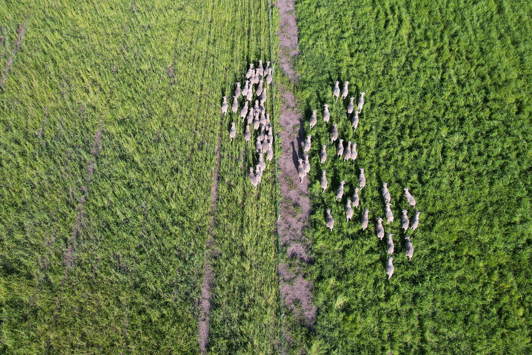Strip grazing is a tactic used to increase feed on offer (FOO) during winter, enabling wool growers to increase or maintain stocking rates, or improve the quality of wool produced.
It involves using temporary fencing to limit grazing of livestock to a narrow strip of pasture in a larger paddock. After grazing, the strip is moved to provide access to fresh pasture. This helps to control grazing patterns of livestock, manages over grazing in high traffic areas, and helps manage pasture growth.
How to use the calculator
Season
Select winter or spring.
Class of sheep
Choose the class of sheep grazing the paddock. The selection affects the daily intake and the stocking rate.
Number of sheep
Enter the total number of sheep. This will be used to calculate the stocking rate.
Total paddock area
Enter the total arable area of the paddock. This will be used to calculate the stocking rate.
Stocking rate check
It is recommended that a total stocking rate of 20-30 DSE/ha be in a paddock. This gives a reasonable time between rotations, allowing the pasture to recover and animal waste to break down before re-grazing occurs. Use this box to calculate the overall stocking rate suggested for the paddock.
Average daily feed intake of sheep
Different sheep have different feed intakes (appetites) and the intake level for the class of sheep chosen is shown as kilograms of dry matter per head (kg/head). It is estimated by calculating the feed intake of the present and residual feed on offer (FOO) and averaging for the number of days grazing.
Residual feed on offer
This is the amount of feed on offer (FOO) that is required to be left in the strip after grazing. Choosing too low a level will affect the ability of the pasture to regrow in time for the next grazing. Choosing too high a level will reduce the value of strip grazing and decrease pasture utilisation and production efficiency.
There are 2 recommended levels for winter (vegetative phase) and spring (reproductive phase).
Winter
- Select 400 kg/DM/ha FOO to maintain liveweight or when pasture growth rate (PGR) is high.
- Select 700 kg/DM/ha feed on offer to allow small liveweight gain or when PGR is low.
- Select Other to enter another value.
Spring
- Select 600 kg/DM/ha feed on offer prior to flowering.
- Select 900 kg/DM/ha feed on offer post flowering, because the ability of the pasture to recover is lower.
- Select Other to enter another value.
For information about food on offer (FOO), see supporting information at the bottom of this page.
Present FOO
Present FOO is the amount of feed on offer in kg/ha of dry matter in the paddock at the present time. A valid entry in this cell is between 1 and 2000.
For information about food on offer (FOO), see supporting information at the bottom of this page.
Width of the paddock
Enter the span of electric fencing to be used, in metres. This is usually the width of the paddock at its narrowest side.
Time grazing the strip
It is recommended that sheep graze the strip for no more than 4 days before being moved to a new strip. Moving sheep twice a week is usually the most efficient on labour and pasture.
Area of strip required
The area of strip required is the area that needs to be provided for the sheep, for the time selected. The length of the strip required is how far apart the portable fences should be, given the width of the paddock. It assumes there is 30% wastage due to trampling and fouling of pasture.

